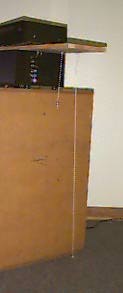 Cork and lead pendulums of the same length
Cork and lead pendulums of the same length
Pendulums are mentioned in both Galileo's Dialogue Concerning the Two Chief World Systems and his Dialogues Concerning Two New Sciences. In these two works, Galileo discusses some of the major points he discovered about pendulums. Follow the links to jump to an experimental evaluation of the claim.
We attempted to reproduce Galileo's findings on these main points and verify his claims. Galileo's techniques had to be modified in several ways to be practical for our resources. For one experiment in Two New Sciences, string lengths of four or five yards are suggested. For these experiments, string lengths of 24.0 cm to 99.4 cm were used. The experiments also used lead and cork balls. For these experiments, egg-shaped fishing weights and a cork fishing float were used.
Time measurement was a major issue in many of Galileo's experiments. For his pendulum experiments, Galileo seems to have compared the pendulums in pairs over the same time. For example, a person would be assigned to each pendulum of the pair and between the words "start" and "stop" each person would count the number of oscillations. This method was used for comparison in these experiments.
 Cork and lead pendulums of the same length
Cork and lead pendulums of the same length
| Number of cork oscillations | 10.0 | 10.0 | 10.0 | 10.0 | 10.0 | 9.9 | 10.0 | 10.0 | 9.9 | 10.0 |
|---|---|---|---|---|---|---|---|---|---|---|
| Number of lead oscillations | 10.0 | 10.0 | 9.9 | 10.1 | 10.1 | 10.0 | 10.0 | 10.0 | 10.0 | 10.0 |
The average number of oscillations for the cork bob was 9.98. The average number of oscillations for the lead bob was 10.01. The percent difference between these averages is 0.300%. For any one measurement, the highest discrepancy was 0.1 oscillation or 1%. Galileo's discovery holds up very well in this test.
| Oscillations of 5 degree release | 30.0 | 30.0 | 30.0 | 30.0 | 30.0 |
|---|---|---|---|---|---|
| Oscillations of 45 degree release | 29.5 | 29.6 | 29.5 | 29.5 | 29.0 |
The pendulum which traveled through the larger angle had a longer period. It averaged 29.42 oscillations during 30 swings of the other, and had fewer oscillations in every trial. Clearly, pendulums with different amplitudes do not have the same period. In fact, it appears that pendulums with larger amplitudes have longer periods. The difference is quite small, though. Whether Galileo's claim is true depends on interpretation of the claim, but the interpretation that identical pendulums of different amplitudes have periods independent of amplitude is false.
 Lead pendulums with one string about four times as long as the other
Lead pendulums with one string about four times as long as the other
| 24.0 cm string | 28.0 | 28.0 | 28.0 | 28.0 | 28.0 |
|---|---|---|---|---|---|
| 50.5 cm string | 20.0 | 19.9 | 19.8 | 20.0 | 19.9 |
Then pendulums of lengths 24.0 cm and 99.4 cm were compared. They were released simulatneously. The shorter pendulum was allowed to pass through 20 cycles as the oscillations of the longer pendulum were counted. The data for these trials is below.
| 24.0 cm string | 20.0 | 20.0 | 20.0 | 20.0 | 20.0 |
|---|---|---|---|---|---|
| 99.4 cm string | 9.75 | 9.25 | 9.7 | 10.0 | 9.75 |
For the first data set, the longer pendulum averaged 19.9 cycles during the shorter ones 28. 19.9/28 is 0.711. The square root of the ratio of their lengths is 0.689. The percent different between these ratios is 3.14%. For the second data set, the longer pendulum averaged 9.69 cycles during the shorter pendulum's 20. The ratio between these two numbers is 0.485. The square root of the ratio of their lengths is 0.491. The percent difference between these ratios is 1.23%. For both experiments, the relationship discovered by Galileo holds well.
 Experiment Group Home Page
Experiment Group Home Page
Last revised April 17, 1995
Michael Morgan